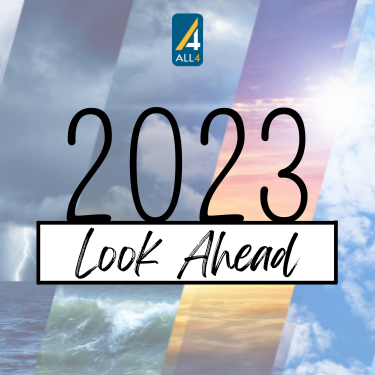
Ozone NAAQS Updates and the Expanded Good Neighbor Policy – What to Expect in 2023
Posted: January 11th, 2023
While U.S. EPA’s reconsideration of the particulate matter less than 2.5 microns (PM2.5) National Ambient Air Quality Standard (NAAQS) has been in the spotlight, there has been far less publicity on the current administration’s October 29, 2021 announcement that U.S. […]
Read article
2023 Climate – Regulatory Lookahead
Posted: January 11th, 2023
President Biden has signed a series of Executive Orders that have set in motion actions by the Executive Branch to address climate change. These actions are driving the development of new rules by the U.S. Environmental Protection Agency (U.S. EPA), […]
Read article
2023 Look Ahead
Posted: January 11th, 2023
Part 1 EHS&S Look Ahead // Colin McCall Greetings from ALL4 in 2023. I’d like to start the year once again by thanking our employees, clients, and partners for the support and for enjoying the journey with us. We never […]
Read article
Analysis of the Recent Report “Examining Supply-Side Options to Achieve 100% Clean Electricity by 2035”
Posted: December 22nd, 2022
Introduction The National Renewable Energy Laboratory (NREL) is a national laboratory of the U.S. Department of Energy that develops renewable energy technologies and strategies to promote the United States’ energy and environmental goals. In 2022, NREL released a report titled […]
Read articleBig Changes for California Annual Emissions Report Starting in 2023
Posted: December 14th, 2022
Recent changes to California’s Criteria Air Pollutants and Toxic Air Contaminants Reporting (CTR) requirements, which were designed to establish a uniform system for reporting annual emissions data and collect more data from stationary sources, are set to start phasing in […]
Read article
The Latest on Startup, Shutdown, and Malfunction (SSM) Provisions in Air Quality Regulations
Posted: November 29th, 2022
There has been a lot of activity regarding Startup, Shutdown, and Malfunction (SSM) provisions in state and federal regulations over the last few years. Namely, exemptions from emissions standards during SSM events are being removed from the regulations. The fundamental […]
Read article
Carolinas Air Quality Updates
Posted: November 7th, 2022
The Carolinas Air Pollution Control Association (CAPCA) hosted the Fall Technical Workshop and Forum on October 12-14, 2022, in Myrtle Beach, South Carolina. The technical sessions included air program updates from the United States Environmental Protection Agency (U.S. EPA) Region […]
Read articleDecarbonization in the Cement Industry and the Role of the Science Based Targets Initiative (SBTi)
Posted: October 27th, 2022
Like the power and transportation industries, decarbonization of the cement industry is crucial for meeting the United Nations Framework Convention on Climate Change’s (UNFCCC) Paris Climate Agreement to limit global warming to well below 2, preferably to 1.5 degrees Celsius, […]
Read article
Reconsideration of the 2008 Fugitive Emissions Rule – What Does it Mean for Your Next Project?
Posted: October 25th, 2022
The United States Environmental Protection Agency (U.S. EPA) is proposing to fully repeal the 2008 Fugitive Emissions Rule that has been stayed, in some form, since September 2009. The U.S. EPA is also proposing to remove an exemption for modifications […]
Read article
Louisiana Court Denies Air Permits for a Greenfield Plastics Complex on Clean Air Act and Environmental Justice Grounds: What are the implications?
Posted: October 13th, 2022
On September 12, 2022, a Louisiana court rejected 14 air permits for a new plastics manufacturing complex to be developed by Formosa Plastics Group (Formosa). The nearly $10 billion complex, known as the “Sunshine Project,” would include 10 chemical manufacturing […]
Read article
